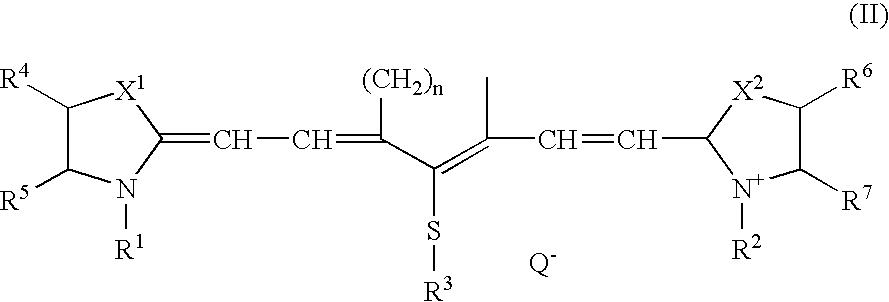Photosensitive composition and planographic printing plate using the same
a technology of composition and planographic printing plate, applied in the direction of thermography, instruments, photosensitive materials, etc., can solve the problems of insufficient image recording properties in the deep portion of the photosensitive material, the density of the density of the developer is affected, and the development latitude is impaired. , to achieve the effect of wide development latitude, high image recording properties and high storage stability
- Summary
- Abstract
- Description
- Claims
- Application Information
AI Technical Summary
Benefits of technology
Problems solved by technology
Method used
Image
Examples
first embodiment
(First Embodiment)
[0021]The first embodiment of the present invention will be described in detail below.
[Infrared Absorbing Agent (a) Represented by the General Formula (I)]
[0022]An infrared absorbing agent represented by the general formula (I) can significantly reduce solubility in an alkali developer at image portions due to mutual action with the above-mentioned polymer compound (b) which is insoluble in water and soluble in alkali aqueous solution. While, at non-image portions, excellent discrimination in forming images is achieved, since to-alkali-solution solubility is recovered by decomposition of the infrared absorbing agent represented by the general formula (I) itself and / or cancellation of the mutual action ascribed to heat generation by absorption of a near infrared ray.
[0023]The above mentioned infrared absorbing agent represented by the general formula (I) will be described further in detail.
[0024]In the general formula (I), each of X1 and X2 independently represents ...
examples
[0188]Hereinafter, the first embodiment will be exemplified according to Examples. However, the scope of the first embodiment is not intended to be limited by the Examples.
Examples 1 to 4
[Preparation of Substrates]
[0189]An aluminum plate (Material: 1050) having a thickness of 0.3 mm was washed and degreased with trichloroethylene, and thereafter this surface was subjected to graining by using a nylon brush and a 400 mesh pumice / water suspension, and then cleanly washed with water. This plate was immersed into an aqueous solution of 25% of sodium hydroxide at a temperature of 45° C. for a period of 9 seconds so as to etch the plate. After washing with water, the plate was furthermore immersed into a 20% nitrous acid for a period of 20 seconds, and water-washed, so that the etched amount on the surface by graining was about 3 g / m2. Next, this plate was anodized by a direct current at a current density of 15 A / dm2 using a 7% sulfuric acid as an electrolyte so as to form an anodized fil...
examples 5 to 8
Example of Synthesis (Copolymer 1)
[0195]31.0 g (0.36 moles) of methacrylic acid, 39.1 g (0.36 moles) of ethyl chloroformate and 200 ml of acetonitrile were introduced into a three neck flask of 500 ml as provided with a stirrer, a condenser tube and a dropping funnel, and the mixture was stirred, while the mixture was cooled on an ice bath. Into the mixture, 36.4 g (0.36 moles) of triethylamine was dropped through the dropping funnel over about one hour. After the dropping was finished, the ice bath was removed, and the mixture was stirred at a room temperature for a period of 30 minutes.
[0196]To this reactant mixture, 51.7 g (0.30 moles) of p-aminobenzensulfonamide was added, and the mixture was stirred for a-period of one hour, while heating at a temperature of 70° C. with an oil bath. After the reaction was finished, this mixture was added to one liter of water, while the water was stirred, and the consequent mixture was stirred for a period of 30 minutes. The mixture was filtrat...
PUM
| Property | Measurement | Unit |
|---|---|---|
| particle size | aaaaa | aaaaa |
| particle size | aaaaa | aaaaa |
| particle size | aaaaa | aaaaa |
Abstract
Description
Claims
Application Information
 Login to View More
Login to View More - R&D
- Intellectual Property
- Life Sciences
- Materials
- Tech Scout
- Unparalleled Data Quality
- Higher Quality Content
- 60% Fewer Hallucinations
Browse by: Latest US Patents, China's latest patents, Technical Efficacy Thesaurus, Application Domain, Technology Topic, Popular Technical Reports.
© 2025 PatSnap. All rights reserved.Legal|Privacy policy|Modern Slavery Act Transparency Statement|Sitemap|About US| Contact US: help@patsnap.com



